دانلود مقاله مروری بر مدلسازی محاسباتی جوشش جریانی در میکروکانالها A Review of Computational Modelling of Flow Boiling in Microchannels

Flow boiling in microchannels has received enormous interest in academic research
over the past few decades because of its importance in the thermal management of
micro-structured devices. A vast number of experimental and theoretical studies have
been reported and an increasing number of computational studies of microchannel flow
boiling have been performed in the past few years. This article provides a review of the
previous studies of flow boiling in microchannels, with a focus on the computational
work. We present the governing equations, boundary conditions, numerical methods
and the mathematical treatment of phase change used. Some important numerical
studies are reviewed in detail and their strengths and weaknesses are presented. Finally,
a summary of the current status of modelling in this area is provided.
دانلود مقاله مروری بر مطالعه پارامتری انتقال حرارت در جوشش استخری نانوسیالها برای افزایش شار حرارتی بحرانی Parametric study of pool boiling heat transfer with nanofluids for the enhancement of critical heat flux: A review
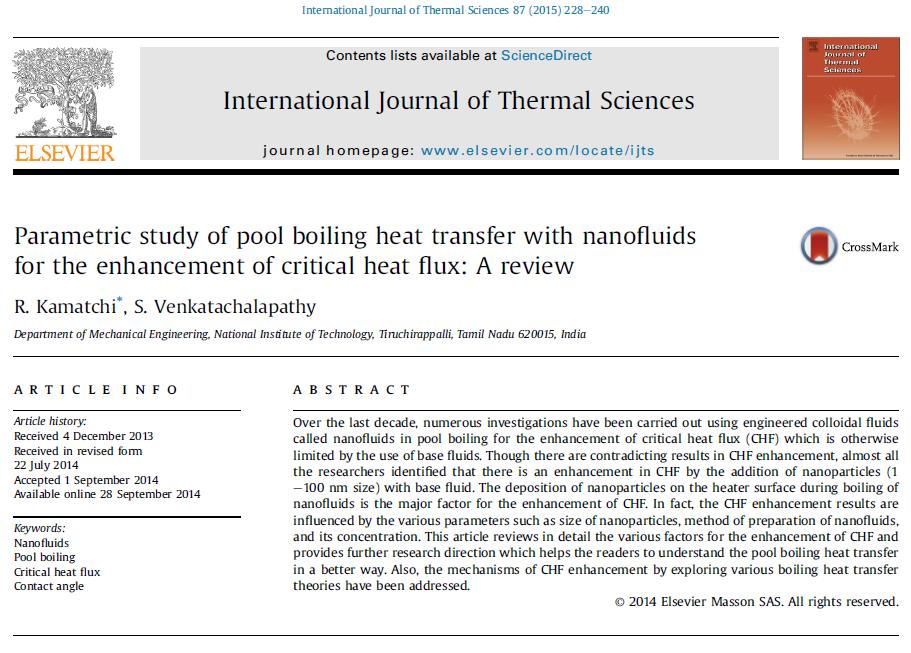
Over the last decade, numerous investigations have been carried out using engineered colloidal fluids
called nanofluids in pool boiling for the enhancement of critical heat flux (CHF) which is otherwise
limited by the use of base fluids. Though there are contradicting results in CHF enhancement, almost all
the researchers identified that there is an enhancement in CHF by the addition of nanoparticles (1
e100 nm size) with base fluid. The deposition of nanoparticles on the heater surface during boiling of
nanofluids is the major factor for the enhancement of CHF. In fact, the CHF enhancement results are
influenced by the various parameters such as size of nanoparticles, method of preparation of nanofluids,
and its concentration. This article reviews in detail the various factors for the enhancement of CHF and
provides further research direction which helps the readers to understand the pool boiling heat transfer
in a better way. Also, the mechanisms of CHF enhancement by exploring various boiling heat transfer
theories have been addressed.
دانلود مقاله مروری بر افزایش انتقال حرارت جوششی نانوسیالها و پوششهای نانو A review of enhancement of boiling heat transfer through nanofluids and nanoparticle coatings

This review traces the development of nanofluid pool boiling from its beginning (1984) to the
present through a sampling of studies that have interested the authors and which have led to the
latest findings at the University of Texas at Arlington (UTA). The studies of thermophysical
properties of nanofluids are briefly covered. Several works in the last 7 years are highlighted to
illustrate the modes of nanofluid pool boiling testing, the variability of nanofluid boiling heat
transfer (BHT), and the postulations of causes of this behavior. Starting in 2006, the wettability
increase in the nanoparticle coating, generated during the nanofluid pool boiling, is recognized as
the source of critical heat flux (CHF) enhancement through its effect on the dynamics of hot spots
and departing bubbles. The reasons for the observed contradictory BHT behavior are not yet fully
clear, but recently at UTA, nanofluid boiling heat transfer has shown to be transient due to the
dynamic nature of the formation of the nanoparticle coating. Also at UTA, the mechanism of
nanoparticle deposition on the heated surface has been further confirmed. Thus, nanofluid boiling
has led back to heat transfer enhancement through surface modification in nanoscale. These
developments from 2006 are covered in more detail.
دانلود مقاله مروری بر انتقال حرارت جوششی نانو سیال ها A review of flow boiling heat transfer of nanofluids

The flow boiling heat transfer of nanofluids is an important research area which provides many
opportunities to explore new frontiers but also poses great challenges. This paper presents a
comprehensive review on the flow boiling heat transfer of nanofluids, with an emphasis on the heat
transfer coefficient (HTC), critical heat flux (CHF), pressure drop, nanofluid stability, flow and heat
transfer mechanism, and flow pattern and bubble dynamics. Most of the available articles have been
related to the first four topics. Studies related to the last two topics are rare, which are reviewed
because of their importance. The important achievements, inconsistence, and contradictions of the
existing research results are identified, and several topics worthy of attention for future investigations
are identified.
دانلود مقاله مروری بر نقش سطوح حکاکی شده با لیزر روی انتقال حرارت جوششی A review on the role of laser textured surfaces on boiling heat transfer
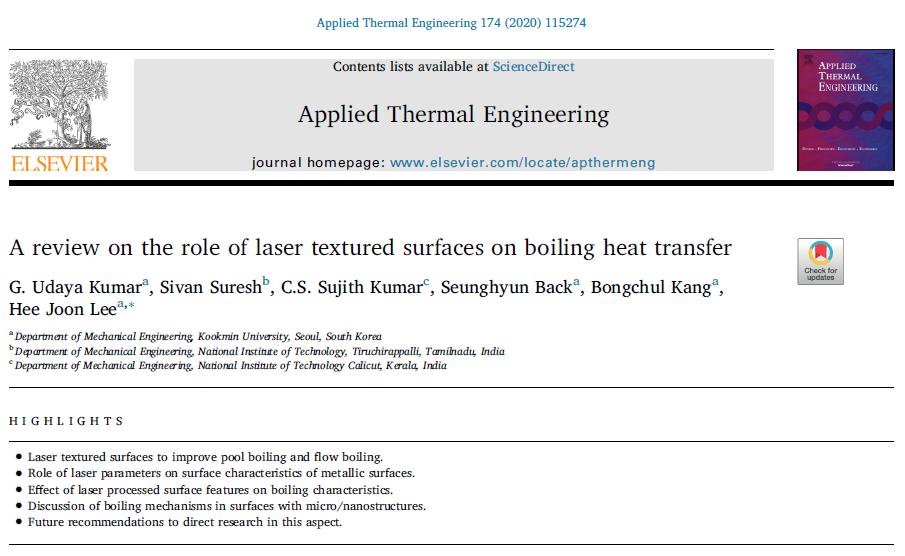
Laser texturing can effectively obtain the desired surface features on metals through melting and solidification,
or through laser-based additive manufacturing techniques. In phase-change heat transfer applications, such
modified surfaces can be both beneficial and durable. Surface modification by ultrafast processing lasers alters
the heat transfer performances of boiling systems. This review summarizes the work leading to these technologies
and their role in influencing the performance of boiling systems. It first discusses the types and material
processing mechanism of lasers. Then, the applications of laser-textured surfaces in pool boiling and flow boiling
are discussed in detail. Different types of surface patterns can be fabricated on boiling surfaces depending on
experimental requirements. It is clearly evident that the design parameters and surface characteristics like
surface roughness, surface wettability, and porosity can be easily controlled by controlling the laser parameters.
Also, heat transfer performance of the textured surfaces changes as compared to the surfaces without any texturing.
As surface features generated as a result of laser texturing are permanent, the durability of the structures
can be increased with prolonged boiling performance. The review concludes with future recommendations for
identifying the research gaps and improving the heat transfer processes by laser-textured surfaces.
دانلود مقاله مرور خلاصه ای بر تاثیر پوشش های سطحی مختلف بر افزایش انتقال حرارت جوشش استخری Influence of different surface coatings on pool boiling heat transfer enhancement: A brief review

The below article provides a brief review of the previously published article on the improvement of pool
boiling heat transfer by modifying the surfaces in different coating techniques. Due to the surface modification
in different coating techniques, the active nucleation site density increases on surfaces, which
leads to enhancement of both heat transfer coefficient (HTC) and Critical Heat flux (CHF). Another reason
for enhancement of boiling heat transfer coefficient is enhancing the uniformity of coating over the heating
surface. This literature also incorporate how the wettability of the surface affect the HTC and CHF
related to different contact angle of working fluid. Different coating material also affects the wettability.
The coating time is found as one of the important parameter on this extensive survey on which affects the
pool Boiling heat Transfer a lot. The heat transfer performance of treated, untreated surface by different
coating techniques also incorporated in the article. The use of different coating techniques such as sintering,
brazing, spraying and electrodeposition was also incorporated in the literature. By using different
coating technique the coating can be formed on the substrate and on that surface Pool boiling occurs
which has a wide application in different industries.
Selection and of the scientific committee of the 10th International Conference of Materials Processing and
Characterization.
دانلود مقاله مروری بر کاربردهای نانومبردها و نانو روانسازها در سیستمهای تبرید، تهویه مطبوع و پمپ حرارتی Applications of nanorefrigerant and nanolubricants in refrigeration, air-conditioning and heat pump systems: A review

Nanorefrigerants are a special type of nanofluidswhich are mixtures of nanoparticles and refrigerants and have a
broad range of applications in diverse fields for instance refrigeration, air conditioning systems, and heat pumps.
In this paper thermal–physical properties of nanoparticles suspended in refrigerant and lubricating oils of
refrigerating systems were reviewed. The effects of nanolubricants on boiling and two phase flow phenomena
are presented as well. Based on results available in the literatures, it has been found that nanorefrigerants have
a much higher and strongly temperature-dependent thermal conductivity at very low particle concentrations
than conventional refrigerant. This can be considered as one of the key parameters for enhanced performance
for refrigeration and air conditioning systems. Because of its superior thermal performances, latest up to date
literatures on this property have been summarized and presented in this paper as well. The results indicate
that HFC134a and mineral oil with TiO2 nanoparticles work normally and safely in the refrigerator with better
performance. The energy consumption of the HFC134a refrigerant using mineral oil and nanoparticles mixture
as lubricant saved 26.1% energy with 0.1% mass fraction TiO2 nanoparticles compared to the HFC134a and POE
oil system.
دانلود مقاله مروری تاریخی بر پیشرفتهای فناوری پمپ های حرارتی کمک شونده با انرژی خورشیدی در قرن بیست و یکم A chronological review of advances in solar assisted heat pump technology in 21st century
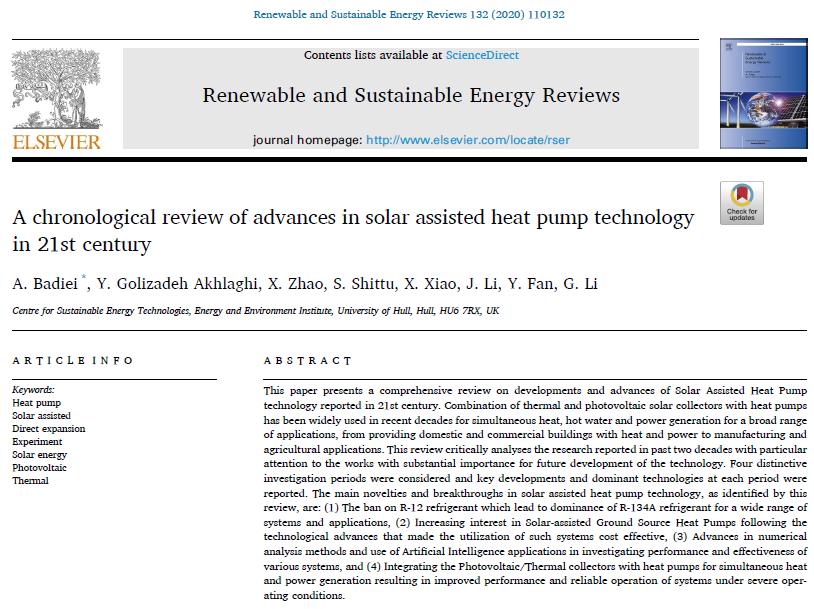
This paper presents a comprehensive review on developments and advances of Solar Assisted Heat Pump
technology reported in 21st century. Combination of thermal and photovoltaic solar collectors with heat pumps
has been widely used in recent decades for simultaneous heat, hot water and power generation for a broad range
of applications, from providing domestic and commercial buildings with heat and power to manufacturing and
agricultural applications. This review critically analyses the research reported in past two decades with particular
attention to the works with substantial importance for future development of the technology. Four distinctive
investigation periods were considered and key developments and dominant technologies at each period were
reported. The main novelties and breakthroughs in solar assisted heat pump technology, as identified by this
review, are: (1) The ban on R-12 refrigerant which lead to dominance of R-134A refrigerant for a wide range of
systems and applications, (2) Increasing interest in Solar-assisted Ground Source Heat Pumps following the
technological advances that made the utilization of such systems cost effective, (3) Advances in numerical
analysis methods and use of Artificial Intelligence applications in investigating performance and effectiveness of
various systems, and (4) Integrating the Photovoltaic/Thermal collectors with heat pumps for simultaneous heat
and power generation resulting in improved performance and reliable operation of systems under severe operating
conditions.
دانلود مقاله مروری بر استفاده از روغن پلاستیک ضایعاتی در موتورهای دیزل Utilization of waste plastic oil in diesel engines: a review
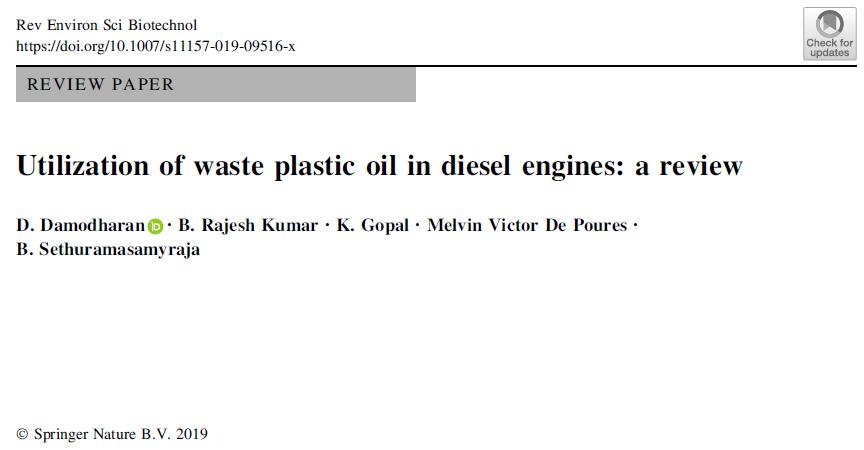
Disposal of waste plastic accumulated in
landfills is critical from the environmental perspective.
The energy embodied in waste plastic could be
recovered by catalytic pyrolysis as waste plastic oil
(WPO) which could be recycled as a fuel for diesel
engines. This method presents a sustainable solution
for (a) waste plastic management as the gap between
global plastic production and waste plastic generation
keeps widening, (b) replacing diesel partially or
wholly which is currently extracted from fast depleting
fossil crude oil. The present work attempts to bring
together all the investigations pertaining to WPO
usage either (a) as a neat fuel or (b) as a blend
component with diesel or (c) with an oxygenated
additive till date in diesel engines and reviews the
engine’s performance, emission and combustion characteristics.
Majority of the works utilised WPO
extracted from mixed waste plastic as a feedstock
using a laboratory scale batch reactor via catalytic
pyrolysis. Silica, Alumina, ZSM-5 and Kaolin were
used as catalysts. This method often yielded up to 80%
of liquid WPO. This oil had a slightly lower cetane
number than fossil diesel and hence produced longer
ignition delays and higher heat releases during
premixed combustion phasing. NOx emissions were
higher with WPO which is addressed by modifying the
injection timing or by means of EGR. Contrary to
popular belief, smoke emissions are mostly lower with
WPO and could be brought down further to Euro
levels by the use of oxygenated additives. In summary,
WPO was found to run smoothly in diesel engines and
more work is necessary to study the PM characterisation
and long-term durability of the engine when
fueled with this oil.
دانلود مقاله مروری بر استفاده از هیدروژن در موتورهای احتراق داخلی (گازوئیل-گاز مایع -دیزل) از دیدگاه عملکرد احتراقی A review ازof hydrogen usage in internal combustion engines (gasoline-Lpg-diesel) from combustion performance aspect
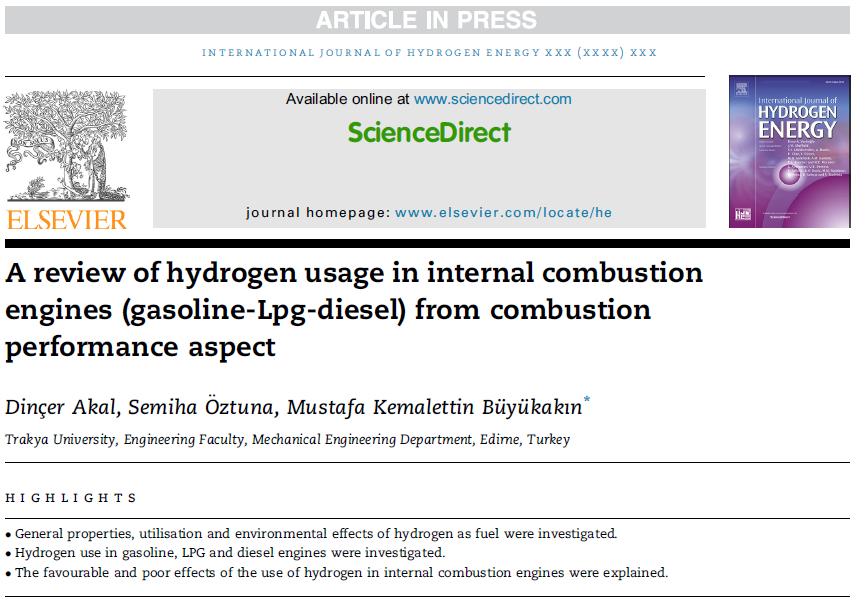
Demand for fossil fuels is increasing day by day with the increase in industrialization and
energy demand in the world. For this reason, many countries are looking for alternative
energy sources against this increasing energy demand. Hydrogen is an alternative fuel with
high efficiency and superior properties. The development of hydrogen-powered vehicles in
the transport sector is expected to reduce fuel consumption and air pollution from exhaust
emissions. In this study, the use of hydrogen as a fuel in vehicles and the current experimental
studies in the literature are examined and the results of using hydrogen as an
additional fuel are investigated. The effects of hydrogen usage on engine performance and
exhaust emissions as an additional fuel to internal combustion gasoline, diesel and LPG
engines are explained. Depending on the amount of hydrogen added to the fuel system, the
engine power and torque are increased at most on petrol engines, while they are decreased
on LPG and diesel engines. In terms of chemical products, the emissions of harmful
exhaust gases in gasoline and LPG engines are reduced, while some diesel engines increase
nitrogen oxide levels. In addition, it is understood that there will be a positive effect on the
environment, due to hydrogen usage in all engine types.